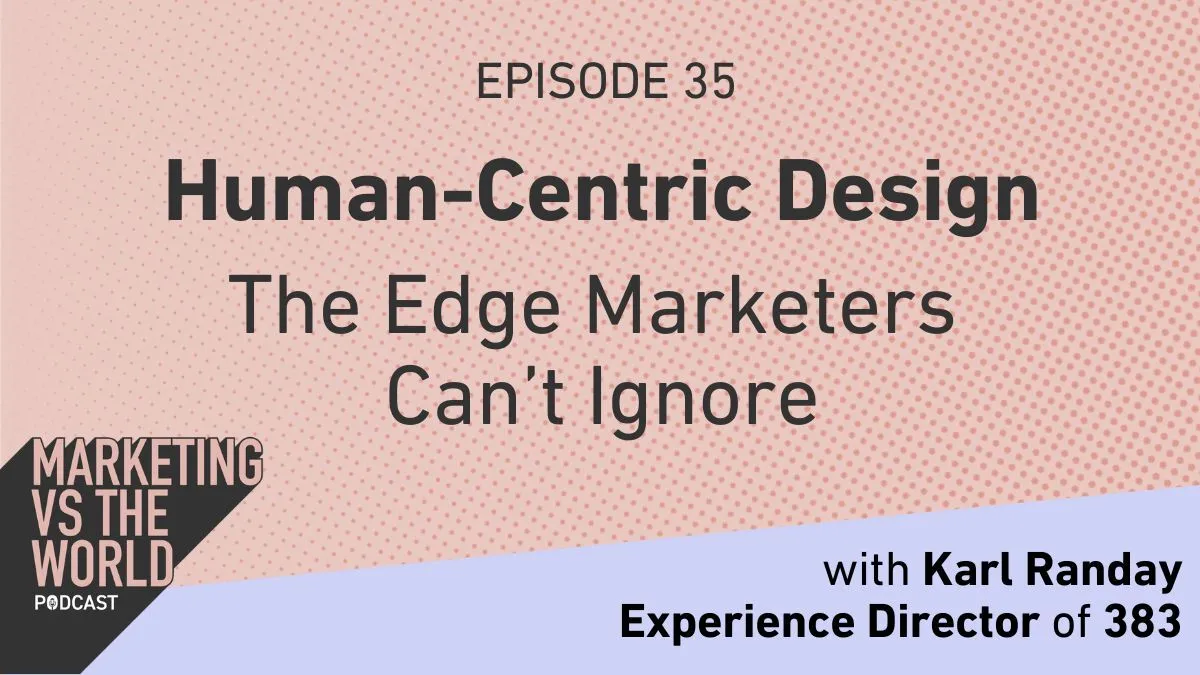Human-Centric Design: The Edge Marketers Can’t Ignore

Marketing vs The World with Karl Randay (Experience Director, 383)
If you’ve ever felt like your website, product or service is nearly there - but something invisible keeps tripping people up - this one’s for you. In this episode, Abbie sits down with Karl Randay, Experience Director at 383, to unpack human-centric design: what it actually is (beyond the buzzword), how to use it without a six-figure research budget, and why it’s the quiet competitive advantage most brands aren’t using.
Listen to the full episode below

What we mean by “human-centric” (and why it isn’t fluffy)
Human-centric design isn’t a mood board or a manifesto. As Karl puts it, it’s a practical way to solve business problems by listening to two groups: the people inside your organisation and the people you serve.
“It’s not just about customers. We sit down and listen to both sides - what the business is trying to achieve, and what the audience is trying to do - then find where it’s misaligned.”
Karl’s route into it is refreshingly honest. He started in “hardcore typography” - the Penguin Books, maths-of-lettering kind - before realising the real power of design isn’t just how things look, it’s how they work:
“Design isn’t just making things pretty. It’s the greatest problem-solving tool in the universe.”
That mindset shift matters. Because when we design for humans first, the metrics follow - lower drop-offs, better conversion, fewer support calls, and happier teams.
Start with assumptions (then stress-test them)
Before you run a single survey, Karl recommends a quick internal diagnostic: what do we believe is true, and what evidence do we have?
“We’ll often start with the five whys. If you ask ‘why?’ five times, you get to the root. It can be irritating… but it works.”
Classic pitfalls he sees:
Teams write pages in internal language that customers don’t recognise.
UX flows prioritise business convenience over real user context.
Data tells you what happened, but not why it happened.
The fix isn’t months of research. It’s right-sized conversations that fill the gaps quickly, then test and iterate.
Research, but keep it light (and useful)
Not everyone needs a 120-page deck. Karl’s team often learns more from a handful of smart conversations than a sprawling study.
“We’ve inherited those big consultancy tomes. Beautiful, but teams don’t know how to use them. Often, five targeted chats plus a quick test gets you further, faster.”
A simple on-site survey can surface gold. Abbie shares one where 70% of visitors turned out to be employees, not employers - a single insight that rewired the entire site strategy. The point isn’t to boil the ocean; it’s to learn just enough to make the next move confidently.
Case study: AA breakdowns, cortisol and two taps
One of Karl’s favourite examples is the AA. The brief wasn’t “make the app prettier”; it was to make a terrifying moment manageable.
“When someone’s tyre blows on the M6, cortisol goes through the roof. They need two taps, not twenty.”
By spending time in call centres, vans, and with drivers, the team shortened the digital breakdown flow so the app beat the phone call - and built tools that helped call-centre staff make sense of complex data fast. The result? An award-winning experience, stronger partner pitches, and an internal capability that kept improving after 383 stepped back.
It’s a useful reminder: the visible UI is the tip of the iceberg. Service design under the surface is what makes the experience feel effortless.
Fluency vs disfluency: when to slow people down
We all love “friction-free”. But sometimes, a touch of friction prevents bigger mistakes. Karl’s example: the shopping basket that mindlessly reuses your last address and card.
“Fluency is doing things fast in the familiar way. Disfluency is intentionally slowing people down. In some flows - address, payment - disfluency saves you from sending dinner to your old hotel.”
Tiny moments of expectation-setting make a huge difference: “Next, we’ll ask for X. You’ll need Y. This will take ~3 minutes.” It’s exactly how GOV.UK makes 50-step processes feel sane. Same principle, better outcomes.
Red flags marketers should spot early
You don’t need to be a UX specialist to smell smoke. If you’re seeing any of these, it’s time to pause and listen:
Drop-offs at key steps (basket, quote, ID check) without an obvious technical cause.
Spikes in support tickets tied to a specific page or flow.
Messaging that’s heavy on features and internal terms, light on meaning for real people.
Chatbots or deflection tactics replacing humans where reassurance is actually needed.
Long, complex journeys with no signposts explaining what’s next.
The fix isn’t a redesign for the sake of it. It’s clarity, sequencing and meeting people where they are (ready to buy vs still figuring it out).
Proving ROI: measure friction, then move the needle
Executives want numbers. Karl’s advice: quantify the friction and build a realistic, staged plan.
“We use a lightweight ‘friction mapping’ approach. Five conversations, and you can point to where problems cost the most. Then you set OKRs for the next 6, 12, 24 weeks - and design for failure with fall-back options.”
Think ranges, not guarantees; pilots, not big-bangs. The outcome you’re selling internally is reduced waste (fewer dead ends, fewer complaints) and increased momentum (faster, clearer paths to value).
How to make human-centric design your competitive edge
Most competitors are optimising the same channels with the same tactics. Human-centric thinking gives you a lever they probably aren’t pulling.
“It sounds woolly, but it’s effective. Sit down and ask the stupidly simple questions: what do we want to do, what’s stopping us, what do our customers want to do, what’s stopping them - and where do those answers meet?”
Start small. Listen. Ship. Learn. Repeat. You’ll move faster than you expect.
Vs the World: Choosing the right kind of “enough”
Away from the day job, Karl shares how his family flipped the script during Covid - moving closer to grandparents, supporting his wife’s legal career to surge, and redefining balance:
“Know what ‘enough’ looks like. Be honest about what matters, then build the life that supports it.”
It’s the same principle as the work: clarity, communication, and designing intentionally for the outcomes you actually want.
The Good Stuff, Summed Up
Human-centric design is practical problem-solving, not a buzzword.
Start by surfacing assumptions on both sides: business and audience.
Keep research right-sized - a few smart conversations can unlock the next move.
Design the service under the surface, not just the screen on top.
Add useful disfluency where mistakes hurt (address, payment, compliance).
Track and tackle friction hot-spots with staged OKRs and fall back options.
Clarity and expectation-setting are your conversion superpowers.
Listen to the full episode with Karl Randay below
Want more from Karl?
If you’re curious about 383’s work or want to explore human-centric design with a team that lives it, check out 383 and Karl’s work. He’s a generous thinker - and this episode only scratches the surface.
Before You Go…
Don’t forget - if you need a hand with SEO, content strategy, or getting your brand seen online, we’re here.
You can connect with Abbie on LinkedIn or get in touch with the Monday Clicks team.
And if human-centred design is on your roadmap, do give this episode a listen - Karl shares loads more detail, examples and quick wins you can borrow tomorrow.
Get in touch
© 2022 Monday Clicks | All rights Reserved | Privacy Policy

